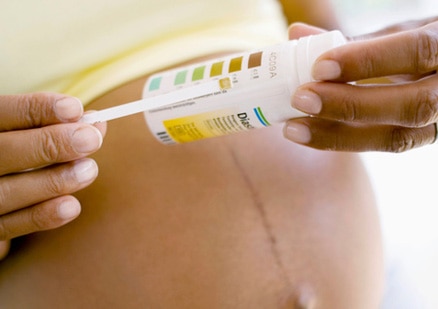Pain relief and fever
If left untreated, pain and fever can lead to serious health risks. For example, fever during pregnancy increases the risk of autism in the baby.1 During pregnancy, acetaminophen (the main ingredient in Tylenol)2 is a safe and effective treatment option for both you and your baby.
Diabetes and gestational diabetes
Unless it’s managed, diabetes can damage your heart, kidneys, nerves, and blood vessels. It also increases your risk for complications during pregnancy. If you’re diabetic, it’s especially important to keep blood sugar under control while you’re pregnant. Managing your diabetes well and monitoring your blood sugar closely will be part of your prenatal care plan from the very start.
Gestational diabetes
Some people have diabetes before they become pregnant. Some develop it during pregnancy, which is known as gestational diabetes. Most people are screened for gestational diabetes between the 24th and 28th weeks of pregnancy, but we may test for it earlier based on your health and family history.
Testing for gestational diabetes is easy but can take 1 to 3 hours. We’ll take a blood sample, give you a sugary drink, and then take another blood sample after you drink it. By looking at the 2 samples, we can see how your body is responding to glucose and whether or not you have gestational diabetes.
If you’re diagnosed with gestational diabetes, we’ll help you learn how to keep it under control and make monitoring your blood sugar part of your prenatal care plan. We’ll also strongly encourage you to breastfeed your baby. Breastfeeding benefits both parents and babies, but it’s especially important for parents with gestational diabetes. That’s because your risk for developing type 2 diabetes later increases if you’ve had gestational diabetes in the past, but breastfeeding your baby cuts that risk in half.3
Learn more about diabetes during pregnancy and how to avoid complications for you and your baby.
Ectopic pregnancy
In an ectopic pregnancy, the fertilized egg attaches itself in a location other than the uterus (most often in the fallopian tube). Unfortunately, there's no way to save an ectopic pregnancy.
Learn more about ectopic pregnancy and how it’s diagnosed and treated.
High-risk pregnancy
Many factors can create a high-risk pregnancy. Age, health problems, and alcohol or drug use are some of the things that can put mothers and babies at risk. And while “high-risk” can sound scary, it really just means you’ll get extra TLC from your care team. We’ll monitor you more closely and might need to see you more often.
Find out what conditions put you at risk, and steps you can take to have a healthy pregnancy.
Miscarriage
A miscarriage is when a pregnancy ends, and the baby is lost before 20 weeks — usually within the first trimester. Miscarriages are physically and emotionally difficult. Disappointment, sadness, anger, and guilt are common emotions for parents dealing with a loss like this. Miscarriages are usually the body’s way of ending a pregnancy that has gotten off to a bad start. Unfortunately, they’re quite common — 10% to 20% of pregnancies result in miscarriage.4
If you have a miscarriage, know that you’re not alone. Reach out to your support network, and give yourself time to grieve. If you need help getting through it, we can help you find it.
Learn about the symptoms and causes of miscarriage.
Obesity
Pregnant people who are obese have a higher risk of problems during pregnancy, including high blood pressure, gestational diabetes, and preeclampsia. And while babies born to parents who are obese have a higher risk of birth defects, it’s important to remember that most pregnant people who are obese have healthy babies.
Learn more about obesity and pregnancy.
Placenta previa
The placenta is your baby’s personal nutrition center. It develops during pregnancy to give oxygen and nutrients to your growing baby through the umbilical cord. Normally, the placenta grows in the upper part of the uterus and doesn’t get in the way of the birth canal. With placenta previa, the placenta attaches to the lowest part of the uterus and covers all or part of the cervix. Although a previa can move away from the cervix as your baby grows, you may need a cesarean section if you still have a placenta previa at the time of birth.
Preeclampsia
Preeclampsia is a kind of high blood pressure that develops only during pregnancy, usually at or after 20 weeks’ gestation. It can keep your baby from getting enough blood and oxygen, and also increases the risk for preterm birth. If you develop preeclampsia, make sure to come to all your prenatal visits so we help you and your baby stay healthy.
Learn more about preeclampsia and what you can do to minimize your risk.
Preterm labor and premature birth
Preterm labor, also known as premature labor, is when labor happens between 20 and 37 weeks — before the pregnancy is full-term. The earlier a baby is born, the greater the chances that they’ll have serious problems. This is because many of your baby’s organs — especially the heart and lungs — aren’t fully developed yet.
Learn the causes and symptoms of preterm labor, and what kind of care a premature infant may need.



